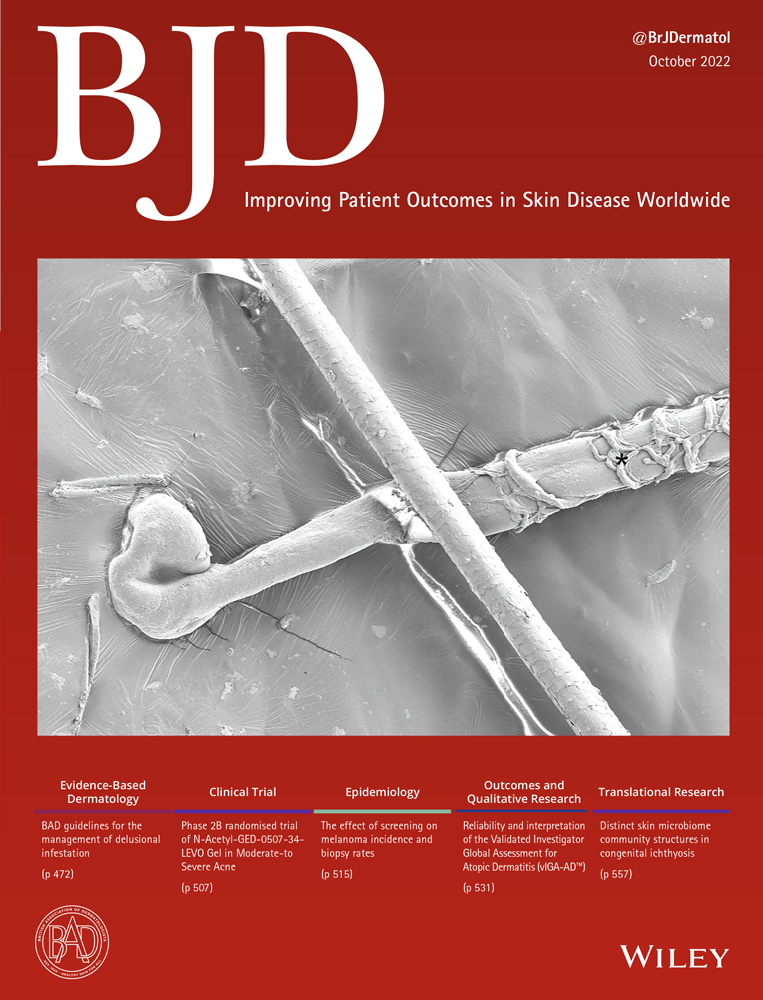Analysis of alopecia areata surveys suggests a threshold for improved patient-reported outcomes
Y.R.Y. and J.C.R. contributed equally.
Summary
Background
Although alopecia areata (AA) greatly impacts patients’ quality of life (QoL), there is no adequate validation of AA-targeted QoL surveys in clinical trials, hindering sufficient representation of patient-reported outcomes.
Objectives
Better understanding of patient-reported outcomes may guide treatment goals and future clinical trials.
Methods
In a recent randomized controlled trial testing dupilumab in AA, patients were administered the Alopecia Areata Quality of Life Index (AA-QLI) and the Alopecia Areata Symptom Impact Scale (AASIS) surveys, specifically evaluating QoL in patients with AA. An in-depth analysis was performed to assess the utility of these questionnaires in this patient population, both at baseline and after treatment, and to determine a threshold for improved patient-reported outcomes.
Results
While AASIS correlated with baseline Severity of Alopecia Tool (SALT) scores and with therapeutic response, AA-QLI showed no correlation with AA severity before or after treatment. Itch strongly correlated with serum IgE levels across both surveys. Using various approaches to estimate a discriminative threshold for decreased impact of AA on QoL (by AASIS) following treatment, a SALT score of 20 points or less post-treatment was associated with improved patient-reported outcomes, including both AA-related symptoms and items within the daily activities/feelings domain such as ‘feeling sad’ and ‘feeling anxious or worry’.
Conclusions
AASIS is better than AA-QLI to assess patient-reported outcomes. SALT ≤ 20 following treatment should be considered as a threshold for meaningful therapeutic outcome and as a clinical endpoint in future clinical trials for AA.
- Alopecia areata greatly compromises quality of life, and affected patients have increased prevalences of depression, anxiety and social phobia.
- Despite the significant negative impact of the disease on patients’ wellbeing, validation of targeted questionnaires in alopecia areata is lacking, and a therapeutic response threshold for improved patient-reported outcomes is unknown.
- This study investigated the utility of two different alopecia areata-targeted questionnaires – Alopecia Areata Quality of Life Index and Alopecia Areata Symptom Impact Scale (AASIS) – in a clinical trial setting.
- AASIS was found to correlate strongly with alopecia areata severity and clinical response.
- Patients with ≤ 20% scalp hair loss after treatment reported improvement in multiple quality-of-life items, suggesting this as a meaningful therapeutic outcome that may guide clinicians and improve the development of future clinical trials.
Conflicts of interest
E.G.Y. has served as a consultant for AbbVie, Amgen, Allergan, Asana Bioscience, Celgene, Concert, Dermira, DS Biopharma, Escalier, Galderma, Glenmark, Kyowa Kirin, LEO Pharma, Lilly, Mitsubishi Tanabe, Novartis, Pfizer, Regeneron, Sanofi and Union Therapeutics; is a member of the advisory boards of Allergan, Asana Bioscience, Celgene, DBV, Dermavant, Dermira, Escalier, Galderma, Glenmark, Kyowa Kirin, LEO Pharma, Lilly, Novartis, Pfizer, Regeneron and Sanofi; and is a recipient of research grants from AbbVie, AnaptysBio, AntibioTx, Asana Bioscience, Boehringer Ingelheim, Celgene, DBV, Dermavant, DS Biopharma, Galderma, Glenmark, Innovaderm, Janssen Biotech, Kiniska Pharma, LEO Pharma, Lilly, Medimmune, Sienna Biopharmaceuticals, Novan, Novartis, Ralexar, Regeneron, Pfizer, UCB and Union Therapeutics. J.G.K. has received grants paid to the Rockefeller University from Amgen, Boehringer Ingelheim, Bristol Myers Squibb, Dermira, Innovaderm, Janssen, Kadmon, Kineta, Kyowa, LEO Pharma, Lilly, Novartis, Paraxel, Pfizer, Provectus, Regeneron and Vitae; and personal fees from AbbVie, Baxter, Biogen Idec, Boehringer Ingelheim, Bristol Myers Squibb, Delenex, Dermira, Janssen, Kadmon, Kineta, Lilly, Merck, Novartis, Pfizer, Sanofi, Serono and XenoPort. All of the other authors declare they have no competing interests.




